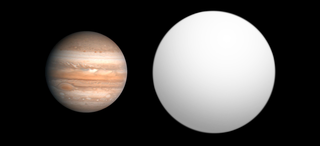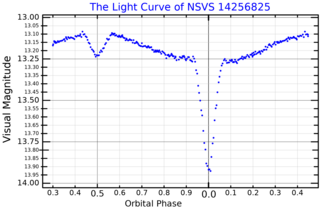Related Research Articles
HD 168443 is an ordinary yellow-hued star in the Serpens Cauda segment of the equatorial constellation of Serpens. It is known to have two substellar companions. With an apparent visual magnitude of 6.92, the star lies just below the nominal lower brightness limit of visibility to the normal human eye. This system is located at a distance of 127 light years from the Sun based on parallax, but is drifting closer with a radial velocity of −48.7 km/s.

54 Piscium is an orange dwarf star approximately 36 light-years away in the constellation of Pisces. In 2003, an extrasolar planet was confirmed to be orbiting the star, and in 2006, a brown dwarf was also discovered orbiting it.
HD 2638 is a ternary star system system in the equatorial constellation of Cetus. The pair have an angular separation of 0.53″ along a position angle of 166.7°, as of 2015. This is system too faint to be visible to the naked eye, having a combined apparent visual magnitude of 9.44; a small telescope is required. The distance to this system is 179.5 light years based on parallax, and it is drifting further away with a radial velocity of +9.6 km/s. The magnitude 7.76 star HD 2567 forms a common proper motion companion to this pair at projected separation 839″.

2M1207b is a planetary-mass object orbiting the brown dwarf 2M1207, in the constellation Centaurus, approximately 170 light-years from Earth. It is one of the first candidate exoplanets to be directly observed. It was discovered in April 2004 by the Very Large Telescope (VLT) at the Paranal Observatory in Chile by a team from the European Southern Observatory led by Gaël Chauvin. It is believed to be from 3 to 10 times the mass of Jupiter and may orbit 2M1207 at a distance roughly as far from the brown dwarf as Pluto is from the Sun.
HD 38529 is a binary star approximately 138 light-years away in the constellation of Orion.
HD 202206 is a binary star system in the southern constellation of Capricornus. With an apparent visual magnitude of +8.1, it is too faint to be visible to the naked eye. It is located at a distance of 150 light years from the Sun based on parallax, and is drifting further away with a radial velocity of +14.7 km/s.
HD 1237 is a binary star system approximately 57 light-years away in the constellation of Hydrus.
HD 92788 is a star in the equatorial constellation of Sextans. It has a yellow hue but is too dim to be visible to the naked eye, having an apparent visual magnitude of 7.31. The star is located at a distance of 113 light years from the Sun based on parallax, but is drifting closer with a radial velocity of −4.5 km/s. Two planets have been found in orbit around the star.
HD 118203 is a star located in the northern circumpolar constellation of Ursa Major. It has the proper name Liesma, which means flame, and it is the name of a character from the Latvian poem Staburags un Liesma. The name was selected in the NameExoWorlds campaign by Latvia, during the 100th anniversary of the IAU.
HD 141937 is a star in the southern zodiac constellation of Libra, positioned a couple of degrees to the north of Lambda Librae. It is a yellow-hued star with an apparent visual magnitude of 7.25, which means it is too faint to be seen with the naked eye. This object is located at a distance of 108.9 light years from the Sun based on parallax, but is drifting closer with a radial velocity of −2.2 km/s. It has an absolute magnitude of 4.71.
HD 190228 is a star with a non-stellar companion in the constellation Vulpecula. Its apparent magnitude is 7.30 – too faint to be seen with the naked eye – and the absolute magnitude is 3.34. Based on parallax measurements, it is located at a distance of 205 light years from the Sun. The star is older than the Sun with an age over 5 billion years and it is metal-poor.
HD 213240 is a possible binary star system in the constellation Grus. It has an apparent visual magnitude of 6.81, which lies below the limit of visibility for normal human sight. The system is located at a distance of 133.5 light years from the Sun based on parallax. The primary has an absolute magnitude of 3.77.
HD 162020 is a star in the southern constellation of Scorpius with a likely red dwarf companion. It has an apparent visual magnitude of 9.10, which is too faint to be visible to the naked eye. The distance to this system is 101 light years based on stellar parallax. It is drifting closer to the Sun with a radial velocity of −27 km/s, and is predicted to come to within ~18 light-years in 1.1 million years.
HD 210277 b is an extrasolar planet orbiting the star HD 210277. It was discovered in September 1998 by the California and Carnegie Planet Search team using the highly successful radial velocity method. The planet is at least 24% more massive than Jupiter. The mean distance of the planet from the star is slightly more than Earth's distance from the Sun. However, the orbit is very eccentric, so at periastron this distance is almost halved, and at apastron it is as distant as Mars is from the Sun.

A circumbinary planet is a planet that orbits two stars instead of one. The two stars orbit each other in a binary system, while the planet typically orbits farther from the center of the system than either of the two stars. In contrast, circumstellar planets in a binary system have stable orbits around one of the two stars, closer in than the orbital distance of the other star. Studies in 2013 showed that there is a strong hint that a circumbinary planet and its stars originate from a single disk.
HD 139357 b is a very massive extrasolar planet or brown dwarf located approximately 390 light years away, orbiting the 6th magnitude K-type giant star HD 139357 in the constellation of Draco. The detection occurred on March 20, 2009, which was the first day of spring.
HD 16760 is a binary star system approximately 227 light-years away in the constellation Perseus. The primary star HD 16760 is a G-type main sequence star similar to the Sun. The secondary, HIP 12635 is 1.521 magnitudes fainter and located at a separation of 14.6 arcseconds from the primary, corresponding to a physical separation of at least 660 AU. Announced in July 2009, HD 16760 has been confirmed to have a red dwarf orbiting it, formerly thought to be a brown dwarf or exoplanet.

NN Serpentis is an eclipsing post-common envelope binary system approximately 1670 light-years away. The system comprises an eclipsing white dwarf and red dwarf. The two stars orbit each other every 0.13 days.

An exoplanet is a planet located outside the Solar System. The first evidence of an exoplanet was noted as early as 1917, but was not recognized as such until 2016; no planet discovery has yet come from that evidence. What turned out to be the first detection of an exoplanet was published among a list of possible candidates in 1988, though not confirmed until 2003. The first confirmed detection came in 1992, with the discovery of terrestrial-mass planets orbiting the pulsar PSR B1257+12. The first confirmation of an exoplanet orbiting a main-sequence star was made in 1995, when a giant planet was found in a four-day orbit around the nearby star 51 Pegasi. Some exoplanets have been imaged directly by telescopes, but the vast majority have been detected through indirect methods, such as the transit method and the radial-velocity method. As of 1 May 2023, there are 5,366 confirmed exoplanets in 3,962 planetary systems, with 856 systems having more than one planet. This is a list of the most notable discoveries.

NSVS 14256825, also known as V1828 Aquilae, is an eclipsing binary system in the constellation of Aquila. The system comprises a subdwarf OB star and red dwarf star. The two stars orbit each other every 2.648976 hours. Based on the stellar parallax of the system, observed by Gaia, the system is located approximately 2,700 light-years away.
References
- 1 2 3 Benedict, G. Fritz; Harrison, Thomas E. (June 2017). "HD 202206: A Circumbinary Brown Dwarf System". The Astronomical Journal. 153 (6): 12. arXiv: 1705.00659 . Bibcode:2017AJ....153..258B. doi:10.3847/1538-3881/aa6d59. S2CID 119105717. 258.
- 1 2 Correia; et al. (2005). "A pair of planets around HD 202206 or a circumbinary planet?". Astronomy & Astrophysics. 440 (2): 751–758. arXiv: astro-ph/0411512 . Bibcode:2005A&A...440..751C. doi:10.1051/0004-6361:20042376. S2CID 16175663.